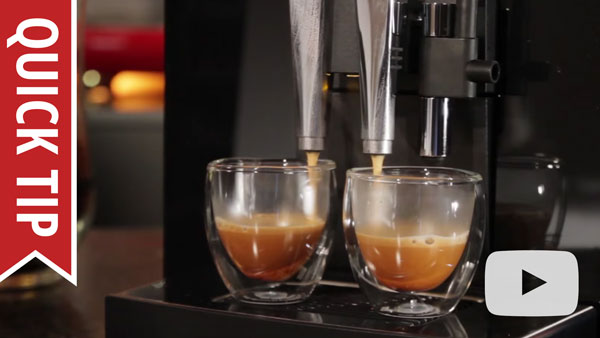Jura Giga 5/troubleshooting
From Whole Latte Love Support Library
No Crema or Bad Tasting Shots
Typically, issues with crema or the flavor of the shot do not indicate a malfunction of the machine. Instead, this indicates that an adjustment needs to be made in the brewing process or that different beans need to be used.
The type of bean that is being used is particularly important for super-automatic machines, because the built in burr grinders only accept certain types of beans. Another consideration is the roast of the bean, which greatly influences how much crema can be produced, as well as the flavor of the shot. Super-automatic machines are not compatible with oily, caramelized, or flavored beans. Properly stored and recently roasted beans are best. You can find more information on why bean selection and storage is important for super-automatic machines by watching the video below.
Appropriately adjusting the grinder is also important. Poor shots can also be the result of incorrect grind settings.
- If the shot is too bitter:
- The grind is set too fine. Try adjusting the grind to a coarser setting, typically indicated by a large dot symbol or higher number.
- If applicable, the aroma setting is set too high. Lower the aroma setting so that less coffee is ground per shot.
- The beans being used are over-roasted, and a lighter roast is needed.
- If the shot is too sour or weak tasting:
- The grind is set too coarse. Try adjusting the grind to a finer setting, indicated by a lower number. Whenever moving the grind to a finer setting it is important to make minor adjustments, and to only adjust the grinder while in operation.
- If there is little crema:
- The beans are probably stale and fresher beans need to be used.
- The grind setting does not match the drink that is being made. Smaller drinks such as an espresso require finer grind size; larger drinks such as a longo require a coarser grind.
- Oily or dark roasted beans are being used. These beans are not compatible with the unit, and are not suitable for espresso brewing. The oils and chemicals that are needed to produce a rich crema have been roasted out of the bean. Switch to a drier/lighter roast.
- Keep the machine properly cleaned and maintained for good tasting shots. Your grinder may need to be cleaned or calibrated, or you may need to descale your machine to remove any unwanted residues or flavors.
Flow Issues
Milk Flows Poorly/Spits
If the milk spout is flowing incorrectly or milk is spraying out then the dual spout is dirty and needs to be cleaned. Run a milk circuit cleaning cycle and disassemble the spout for cleaning.
Poor Coffee Flow
There are a couple of different reasons the coffee could be flowing slowly.
- The coffee grind is set too fine, and the fine coffee particles are blocking the flow of water. Try adjusting the grind to a coarser setting.
- The Clearyl filter is blocking the flow of water, and may be due for replacement.
- There is scale buildup in the system and the machine should be descaled.
Grinder Issues
If the machine is not recognizing that the bean hoppers are empty, or if the machine gives a "Fill bean container" error even though the hoppers are full then the grinding mechanism needs to be cleaned. Instructions for cleaning the grinding mechanism can be found on p. 50 of the machine manual.
Empty Drip Tray Won't Clear
If the "Empty drip tray" error will not clear then the metal contacts on the drip tray are dirty or wet. Wipe the contacts off and dry them thoroughly before reinserting the tray into the machine.
Error 2
The machine was exposed to cold or freezing conditions, and the machine will not operate until the machine has reached room temperature.

